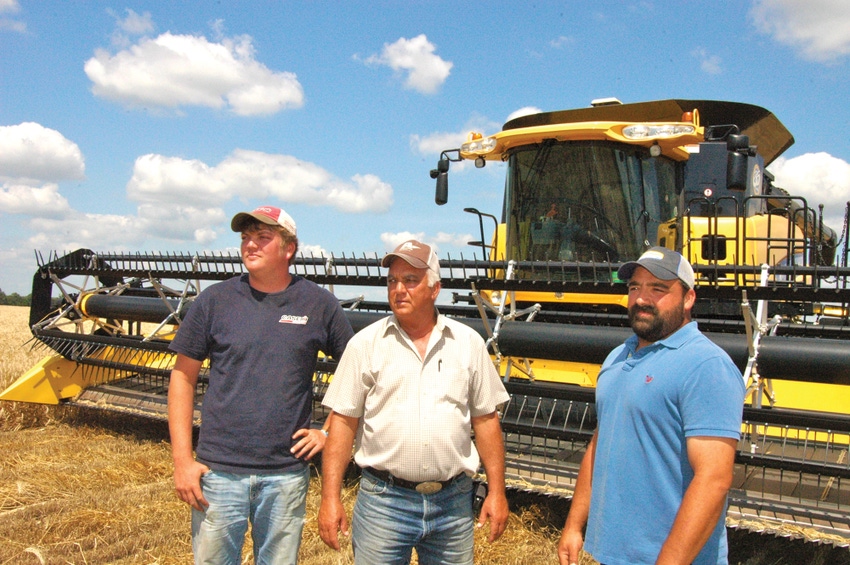July 27, 2012

Ricky Campbell can nearly guarantee a 1,000-pound or better cotton crop. But it’s hard to beat a strong crop rotation of corn, soybeans and wheat on his northeast Louisiana family farm.
Campbell farms with his sons, Ricky Jr. and Johnathon, around Winnsboro, La. Like other Delta areas, cotton ruled agriculture here for well over a century. However, with December 2012 cotton futures priced just a little above 70 cents a pound, these days they are more interested in crops measured in bushels.
Their corn, wheat and soybean rotations help them take advantage of stronger markets for grain, even though they have backed off some. Their seriousness about wheat, corn and soybeans was evident at wheat harvest this spring as they ran a just-off-the-showroom-floor New Holland combine. “We want to make sure we have equipment that will allow for a smooth harvest,” Ricky Jr. says.
This year’s wheat crop made 60 bushels to 70 bushels per acre and was followed by double-cropped soybeans. Those will be followed by corn next spring, then wheat next fall. “That’s a rotation that is working well for us and helps us get the most out of our irrigation water,” Ricky says, as he manages his 39th year of farming in the region.
Much of the success of their program is attributed to a minimum tillage plan that involves getting the most out of wheat straw following harvest in May. “We farm mostly silt loam soil,” Ricky Jr. says. “By not burning the straw and planting into the stubble, we keep the soil mellow for double-cropped beans and helps keep the ground covered to hold back weed pressure.”
Delta crops endure as heat wears on — photo gallery
Double-cropped soybeans are planted in 38-inch rows and sown at a rate of 9-10 seeds per foot, or about 50 pounds per acre. Beans are treated to prevent insect damage to young plants.
“We apply a fungicide to the soybean seed prior to planting, based on our consultant’s advice,” Ricky Jr. adds, “We also apply an inoculant to the seed to help boost nodulation. We’ll fly on a foliar fungicide to prevent possible disease damage up to the R-5 level.”
In their corn program, all hybrids are stacked with Roundup Ready and Bt genes except for the required refuge with non-Bt. The plant population is 32,000 plants to 33,000 plants per acre. “We haven’t seen any insect or weed resistance yet in our corn,” Ricky Jr. says. “Our main weed problem is with grass. A tank mix of atrazine and a residual herbicide helps control grasses.
Soil samples
Soil samples are taken in the fall to determine the nutrient needs for corn the following year. They normally apply needed phosphorous and potassium in the fall. Overall, 200 units to 215 units of nitrogen are applied for a corn crop.
They also put down P and K and about 25 units of N applied at corn planting. They apply 50 pounds of ammonium sulfate and 100 pounds of urea after emergence the end of February and 100 pounds of urea applied about two weeks later.
“A fungicide is also applied to corn at about the tassel stage,” Johnathon says, either Headline or Quilt, to help protect the crop against southern rust or other diseases.
“Our corn yields can be over 200 bushels one year or they may be 160 bushels to 170 bushels the next, depending on how hot and dry the summer is,” Ricky says, adding that this year’s corn was planted in four different stages throughout March due to heavy rains that stalled planting. “We had some corn planted in early March that was tasseling in early May because of the warm April. Some other corn was still barely waist high then.”
Their wheat is normally planted in late October or early November following corn or soybean harvest.
Feature: Bill Spain 2012 Mississippi Farmer of the Year
The Campbells like the value of the double-cropped wheat-beans, as well as early planted beans and corn. For example, 70-bushel wheat at $6.50 per bushel grosses $455 per acre, while 50-bushel soybeans at $12 grosses $600. That’s a total of $1,055 per acre. “You have lower input costs for wheat and soybeans,” Ricky Jr. says.
That doesn’t quite reach a gross return of $1,200 per acre from 200-bushel corn at $6 a bushel. But with high fertilizer costs and other inputs, a breakeven price that pushes $5 bushel or more may be needed, the Campbells say.
They look to information provided by Carol Pinnell-Alison, county agent, Franklin Parish, to help get the most out of their production system. “The LSU AgCenter has been helpful to us,” Ricky says. “We have learned to get more out of our corn, beans and wheat and not have to rely on cotton. We’ll still plant cotton on occasion after wheat. But in general, a corn, wheat and beans work better for us.”
About the Author(s)
You May Also Like




